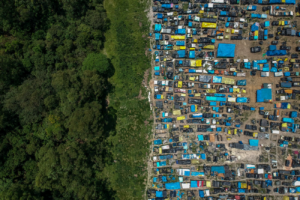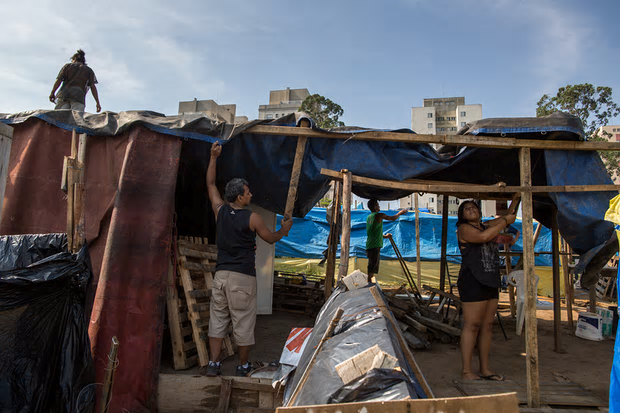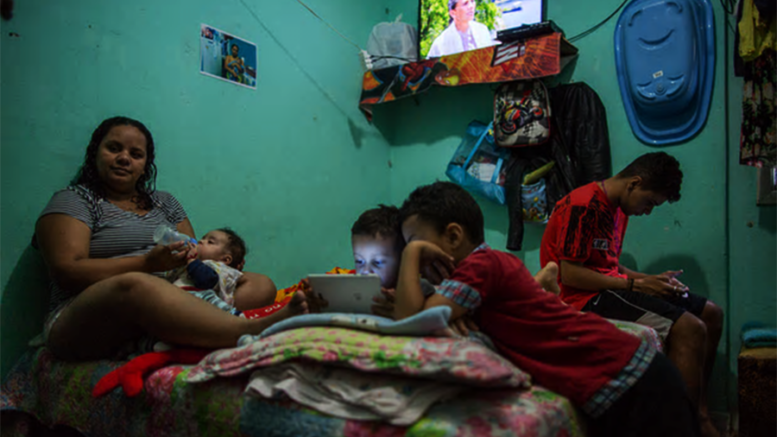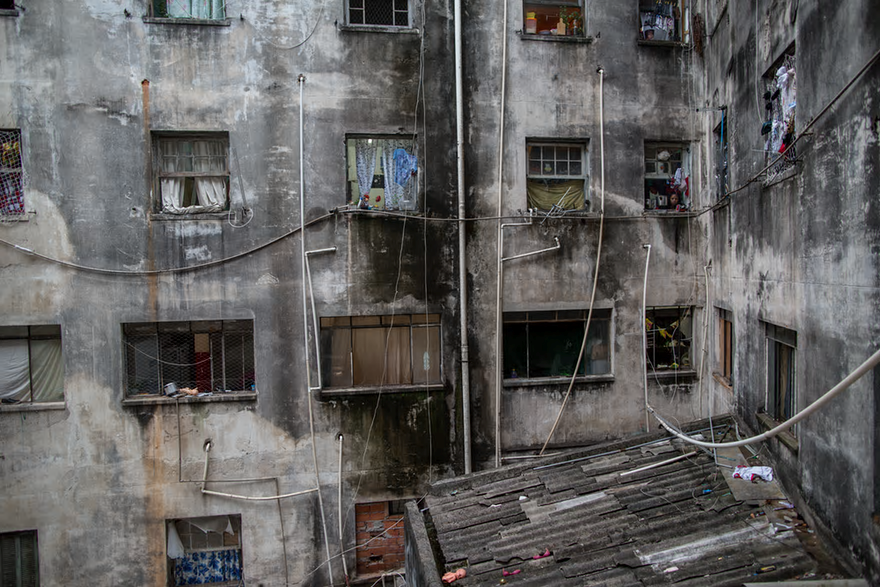The following is by Jonathan Watts (The Guardian 27 November 2017) and gives a good account of the growing squatter mo0vment in Brazil’s in São Paulo. It is part the of Guardian Cities series, funded by the Rockefeller Foundation. For those who might be disturbed by this, it remains that this is a good account of what is going on and shows that people are acting to overcome the crisis in housing affordability. All photographs by Flavio Forner
On the wall of an abandoned and occupied hotel in central São Paulo is a mural of a fiercely feral creature – part cat, part rat, part alien – that bears a red revolutionary banner with a single word: Resistência!
The surrounding courtyard is daubed with slogans of defiance – “10 years of struggle!”, “Whoever doesn’t struggle is dead” – and the initials MMLJ (the Movement of Residents Fighting for Justice).
Young boys kick a ball against a wall decorated with a giant photograph of masked, armed protesters. A mother nurses her baby beside a doorway punched through a brick wall scrawled with the most ubiquitous graffiti in modern Brazil: Fora Temer (President Michel Temer Out!)
In the surrounding blocks, 237 low-income families talk, cook, clean, watch TV, shop, practice capoeira, study literacy, sleep and go about their daily lives in Brazil’s most famous illegal squat.
This is the Mauá Occupation, a trailblazer for an increasingly organised fair-housing movement that has reignited debate about whether urban development should aim at gentrification or helping the growing ranks of people forced to live on the street and in the periphery.
When the Santos Dumont hotel was first taken over on the 25 March 2007, there were very few organised squats in South America’s biggest city. But recession, inequality and increasing political polarisation have turned the occupation movement into one of the most dynamic forces in the country.
There are now about 80 organised squats in the city centre and its environs, including high-rise communities and centres of radical art. The periphery is home to many more, such as the giant “Povos Sem Medo” (People Without Fear) cluster of 8,000 tents in the São Bernardo do Campo district.
The burst of energy and activism has been compared to the key transitional periods for other major cities in the 1970s, 80s and 90s.
“We are now seeing a boom of squatting in São Paulo that is like those once seen in New York, Berlin and Barcelona,” said Raquel Rolnik, a former UN Special Rapporteur and architect who has worked in the housing sector for more than three decades. “What is happening here is not unique but it is happening on a very wide scale.”
For optimists, this is part of a cycle of reinvention that is long overdue. For much of the 20th century, São Paulo was the engine of the national economy, at one point accounting for 44 percent of Brazil’s GDP, and the city centre was home to a rich elite, who lived in art-deco and modernist buildings. But Brazil’s wealth diffused geographically and the city centre fell into decline due to poor planning, floods, rising crime and drug problems – particularly around the Luz area, which became known as Cracolândia (Crackland). For much of the past few decades, the city centre – and its poor residents – have been the victims of neglect.
Now, however, it is the focus of a battle for territory and ideas between developers who want to gentrify the downtown area and increasingly organised occupation movements that resist the relocation of the poor to the periphery. For Rolnik, the residents of Mauá are the “superstars” of this campaign.
The residents were due to be evicted last week, but they won a last minute reprieve when the city government agreed to buy the building from the owner for R$20m (£4.6m) and use the space for social housing. Now, the battle is for how many of the current inhabitants will be allowed to remain.
“We’re still in a struggle,” said Ivaneti de Araújo, one of the organisers affiliated with the Front for the Struggle for Housing, FLM. “We want the government to guarantee that all the families can stay here.”

The giant ‘Povos Sem Medo’ (People Without Fear) cluster of 8,000 tents in the São Bernardo do Campo district
Araújo and her husband moved to the city from the interior of São Paulo almost 20 years ago. They hoped for a better life, but were unable to find work. They ended up living on the street for four months until they joined an occupation. It was to be the first of many as she became an activist as well as a resident. Now 45 years old, she has spent almost half her life in the campaign for affordable housing.
“It’s a constant struggle. I’ve been arrested, beaten many times and accused of crimes I didn’t commit,” she says. “In all this time, almost nothing has changed. There have been progressive moves and then steps back to zero. Election years are usually the worst.”
Although the housing issue is usually framed in the class struggle terms of poor residents fighting against middle class gentrification, Araújo has been involved long enough to know that ideological labels and party alliances are not always a reliable guide to effectiveness.
The right-wing administration of the current mayor João Doria has largely tried to undermine the city’s already weak social welfare provision and bring in more private business. But Araújo is impressed by the current housing secretary Fernando Chucre.
“I don’t agree with his policies, but I feel he is dedicated. Of all the officials I have encountered so far, he is the most engaged,” she says, showing on her mobile phone how he is willing to talk directly to the occupation movement leader even late at night. “He wants to use empty buildings for social housing. That’s a good idea. But we know it’s not just up to him. If he gets pushed out, it could all change.”
In an interview the government office, Chucre is frank about the scale of the challenge. “The problem of Brazil and São Paulo in particular is that we cannot provide enough housing for low-income families,” he says. More than 370,000 people need new homes because they live in dangerous or illegal conditions. Another million need upgrades.
Then there are the growing ranks of the homeless. According the last census in 2015, there were 15,000 people living on the streets. Chucre estimates the number is now likely to be closer to 20,000 and is probably the worst homeless situation in the city’s history.
To ease the pressure, he wants to utilise the 720 empty or under-used buildings in the central metropolitan districts. Nine (including Mauá and two other occupations) have been identified as “transition shelters” for vulnerable groups including the elderly and victims of domestic violence. To jump-start other moribund units, the government will penalise owners of empty buildings by doubling the property rates every year the rates go unpaid. If this continues for five years, the government will go to the courts.
His more ambitious goal is to build 25,000 new homes by 2020 – far more than the 14,000 built under the previous administration. To do this, he says, public-private partnerships are essential because even if he tapped every public fund available for this purpose it would only be enough for 4,000 homes per year.
“There are those who are ideologically opposed to PPPs, which makes them work against the interests of low-income people because 88% of the homes we are building in the Luz district are for low-income families.
He accepts that there is a risk of gentrification if the new homes are bought up by middle-class investors. To counter this, he is considering social housing that remains under public ownership.
“I share their concerns about gentrification. It’s a global problem. We need to guarantee more areas that are obligatory for social housing with a permanent place for low-income residents.”
Ermínia Maricato, a professor of urbanism at the University of São Paulo, believes this is a ruse.
“There is a big fight for the centre. On one side, the poor want to live there because that’s where the jobs are. On the other, the markets are trying to push them out,” she says. “Look what they did in Rio for the Olympics. They moved 6-10,000 people out to the periphery. That’s what they want to do here. They claim the city centre is dead. But it’s not. It’s alive. These occupations prove that.”
 For her, the dynamic reflects a broader trend in Brazil, where city centres are becoming whiter and richer, while the peripheries are black and poor. Pulling up a series of charts, she shows the discrepancy in terms of jobs (70% of which are in the central area), race and life expectancy, which ranges from 56 in the poor fringes to almost 80 in the rich centre.
For her, the dynamic reflects a broader trend in Brazil, where city centres are becoming whiter and richer, while the peripheries are black and poor. Pulling up a series of charts, she shows the discrepancy in terms of jobs (70% of which are in the central area), race and life expectancy, which ranges from 56 in the poor fringes to almost 80 in the rich centre.
“This is scandalous,” she says, referring to the problem as a result of the country’s history as the world’s biggest slaving nation. “This is why this won’t end like New York or Berlin. The historical legacy is completely different.”
While the political battle rages, the problem grows. The homeless are evident everywhere: in makeshift tents under the Jaceguai viaduct, in Tietê bus station, begging on the roadside of the swanky Avenida Paulista, sprawled across the floors near the Sé cathedral and the municipal art museum.
“This is the worst situation ever,” said Kaká Ferreira, the founder of Anjos da Noite (Angels of the Night), an organisation that has distributed food and clothes to the homeless for 27 years. “We have seen a surge in homeless numbers. We don’t have the capacity to respond. It’s not just the homeless. Even the squatters are asking us for food. We can’t say no.”
Among the newest arrivals is 15-year-old Daiene Costa who was sitting with her sister on the concrete pavement near the art museum. “We have no mum and our aunt, who was looking after us, couldn’t pay the rent so we’re going to live on the street,” she said. She was pointed in the direction of a shelter, but this was no guarantee of a bed.
According to officials, there is temporary accommodation for less than half of the 20,000 homeless. The government plans to build more shelters, but their role has changed under the current pro-business administration to be more focussed on training people to re-enter the workforce. Felipe Sabar, secretary of social development and assistance, told the Guardian earlier this year that he was making arrangements with McDonald’s, Unilever, Drogaria and other companies to arrange 20,000 jobs.
“This is a first. The idea is to help those who want to go back to work. We will offer training that is part-technical and part-emotional, he says. “There is meditation, music, dancing and reconnection of mind, body and soul. It helps people to want to go back to work.”
This too has become highly politicised.
For critics, this idea is unpractical because many homeless suffer from deep-rooted mental illness, disability or drug addiction that a few sessions of meditation are not going to help. “The idea is too simplistic,” said Luciana Temer, who was social secretary in the previous Workers Party administration. “For some it might work. But for others it will not. The government needs to face the fact that some people will need the state for their whole life.”
But those homeless people who can cope with autonomy are now looking at Occupation Mauá as an inspiration: they are organising, stressing their rights and pushing for an alternative to the government’s top-down approach. Last week, a group from the National Movement of Street Dwellers marched through São Paulo bearing banners demanding “Dignified Housing”.
São Paulo’s centre is an increasingly contested space not just for housing, but for ideas that have implications far beyond the city’s borders, according to Guilherme Boulos of the National Coordination of the Movement of Homeless Workers. He believes the occupations are a sign that public policy is failing the homeless and the marginalised.
“At this moment it is important to understand that in Brazil there is a process of resistance expressed in the occupations, which is increasing daily in the country,” he said. “In the centre, specifically, it is a very important symbolic dispute, because it is a campaign for the poor’s right
Chucre, the housing secretary, says he agrees with the sentiment – but not with the solutions proposed by the left. Instead of grand-megaprojects that aim to transform the downtown area, he wants to focus on smaller developments that can be realised in the time frame of a single administration and within budget restraints. “We have a planning department with literally hundreds of projects. But they have all failed due a lack of time or money. I don’t believe in a big project to save the city centre. I prefer small interventions that can encourage private investment.”
At Occupation Mauá, the residents are enjoying the benefits of this pragmatism, though few expect the housing secretary’s relatively benign housing policy to last, given the track record of past administrations.
“We must be cautious. The public-private partnership is not for the poor. There is still a risk that we will be expelled in the future. If the government continues with the idea of clearing out the city centre and pushing ahead with gentrification, then there will be more pressure on us to leave,” said Araújo. “We must continue our struggle and find new ways to resist.”



Be the first to comment on "São Paulo’s homeless seize the city"